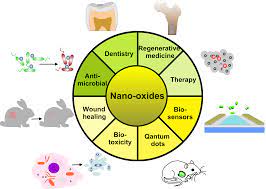
PROPERTIES OF Metal Oxide Nanoparticles: The current knowledge on oxide materials allows to affirm that most
of their physical-chemical properties display an acute size dependence. Physical-chemical properties of special
relevance in Chemistry are mostly related to the industrial use of oxides as sensors, ceramics, absorbents and/or
catalysts. A bunch of novel application within these fields rely on the size-dependence of the optical, (electronic
and/or ionic)transport, mechanical and, obviously, surface/chemical (redox, acid/base) properties Metal Oxide
Nanoparticles. We should stress that size effects in oxide chemistry have frequently two interrelated faces,
structural/electronic quantum-size and size-defect or non-stoichiometry effects. Hence, here we will describe
the influence of these two phenomena in the main physic-chemical properties of oxides
THE WORLD OF Metal Oxide Nanoparticles
Metal Oxide Nanoparticles play a very important role in many areas of chemistry, physics and materials science.
The metal elements are able to form a large diversity of oxide compounds. These can adopt a vast number of
structural geometries with an electronic structure that can exhibit metallic, semiconductor or insulator character.
In technological applications,Metal Oxide Nanoparticles are used in the fabrication of microelectronic circuits,
sensors, piezoelectric devices, fuel cells, coatings for the passivation of surfaces against corrosion, and as
catalysts. In the emerging field of nanotechnology, a goal is to make nanostructures or nano arrays with special
properties with respect to those of bulk or single particle species.
Metal Oxide Nanoparticles can exhibit unique physical and chemical properties due to their limited size and a
high density of corner or edge surface sites. Particle size is expected to influence three important groups of
basic properties in any material. The first one comprises the structural characteristics, namely the lattice
symmetry and cell parameters. Bulk oxides are usually robust and stable systems with well-defined crystallographic structures.
However, the growing importance of surface free energy and stress with decreasing
particle size must be considered: changes in thermodynamic stability associate with size can induce modification
of cell parameters and/or structural transformations and in extreme cases the Metal Oxide Nanoparticles can
disappear due to interactions with its surrounding environment and a high surface free energy. In order to
display mechanical or structural stability, metal oxide nanoparticles must have a low surface free energy.
Metal Oxide Nanoparticles As the particle size decreases, the increasing number of surface and interface atoms
generates stress/strain and concomitant structural perturbations. Beyond this “intrinsic” strain, there may be also
“extrinsic” strain associated with a particular synthesis method which may be partially relieved by annealing or
calcinations. Also, non-stoichiometry is a common phenomenon. On the other hand, interactions with the
substrate on which the Metal Oxide Nanoparticles are supported can complicate the situation and induce
structural perturbations or phases not seen for the bulk state of the oxides.
We invite you to contact us Metal Oxide Nanoparticles for further information about our company and our
capabilities. If you want to buy nanomaterials or discuss Metal Oxide Nanoparticles
